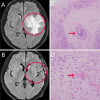Case report: intracranial lesions in a patient with anxiety and depression: tumor recurrence or radiation encephalopathy?
- PMID: 39211558
- PMCID: PMC11358061
- DOI: 10.3389/fonc.2024.1422765
Case report: intracranial lesions in a patient with anxiety and depression: tumor recurrence or radiation encephalopathy?
Abstract
Purpose: Radiation encephalopathy (REP) is one of the most common complications of radiotherapy for malignant tumors of the head and neck. Symptoms usually appear months to years following radiotherapy, with headache, insomnia, and memory loss as the main clinical features. We report a patient who was admitted to the hospital with anxiety and depressive disorder and was eventually diagnosed with REP.
Patients and methods: A 48-year-old patient who had undergone over 2 years of radiotherapy for nasopharyngeal carcinoma was admitted to the Department of Psychosomatic Medicine of our hospital because of recurrent fear, low mood, and waking up from dreams. Magnetic resonance imaging (MRI) revealed a mass in the left temporal lobe with a large peripheral edema. After multidisciplinary consultation, the possibility of tumor recurrence could not be excluded.
Results: Resection of the lesioned brain tissue to obtain pathological tissue showed glial cell proliferation and small focal areas of degeneration and necrosis, which indicated that the lesions were inflammatory. Postoperative MRI showed no abnormal signal, and the patient's condition improved.
Conclusion: Nasopharyngeal carcinoma patients with a history of radiotherapy and symptoms of increased intracranial pressure and neurological damage should be examined for REP. Furthermore, patients may experience anxiety and depressive disorders as a result of temporal lobe damage caused by REP.
Keywords: anxiety disorders; depressive disorders; nasopharyngeal cancer; radiation encephalopathy; radiotherapy.
Copyright © 2024 You, He, Ouyang, Yang, Xie, Zhou, Zhang and Shi.
Conflict of interest statement
The authors declare that the research was conducted in the absence of any commercial or financial relationships that could be construed as a potential conflict of interest.
Figures

Similar articles
-
Letter to the Editor: Depression As The First Symptom Of Frontal Lobe Grade 2 Malignant Glioma.Turk Psikiyatri Derg. 2022 Summer;33(2):143-145. doi: 10.5080/u25957. Turk Psikiyatri Derg. 2022. PMID: 35730515 English, Turkish.
-
Neuroimaging for the evaluation of chronic headaches: an evidence-based analysis.Ont Health Technol Assess Ser. 2010;10(26):1-57. Epub 2010 Dec 1. Ont Health Technol Assess Ser. 2010. PMID: 23074404 Free PMC article.
-
[Magnetic resonance imaging (MRI) findings of temporal lobe radiation encephalopathy].Ai Zheng. 2003 Nov;22(11):1209-13. Ai Zheng. 2003. PMID: 14613655 Chinese.
-
Research progress on mechanism and imaging of temporal lobe injury induced by radiotherapy for head and neck cancer.Eur Radiol. 2022 Jan;32(1):319-330. doi: 10.1007/s00330-021-08164-6. Epub 2021 Jul 29. Eur Radiol. 2022. PMID: 34327577 Review.
-
How successful is high-dose (> or = 60 Gy) reirradiation using mainly external beams in salvaging local failures of nasopharyngeal carcinoma?Int J Radiat Oncol Biol Phys. 1998 Mar 1;40(4):897-913. doi: 10.1016/s0360-3016(97)00854-7. Int J Radiat Oncol Biol Phys. 1998. PMID: 9531376 Review.
Cited by
-
Gene-level connections between anxiety disorders, ADHD, and head and neck cancer: insights from a computational biology approach.Front Psychiatry. 2025 Mar 20;16:1552815. doi: 10.3389/fpsyt.2025.1552815. eCollection 2025. Front Psychiatry. 2025. PMID: 40182194 Free PMC article.
-
Depression and Anxiety After Radiation-Induced Brain Injury: A Review of Current Research Progress.Curr Oncol. 2025 Jul 26;32(8):419. doi: 10.3390/curroncol32080419. Curr Oncol. 2025. PMID: 40862788 Free PMC article. Review.
References
-
- Baidoun F, Mahmoud AR, Kamel MG. A Commentary on: Long-term outcomes of induction chemotherapy followed by intensity modulated radiotherapy and adjuvant chemotherapy in nasopharyngeal carcinoma patients with N3 disease. Transl Oncol. (2022) 15:101278. doi: 10.1016/j.tranon.2021.101278 - DOI - PMC - PubMed
-
- Aribas BK, Cetindag F, Ozdogan Z, Dizman A, Demir P, Unlu DN, et al. . Nasopharyngeal carcinomas: prognostic factors and treatment features. J Egypt Natl Canc Inst. (2008) 20:230–6. - PubMed
Publication types
LinkOut - more resources
Full Text Sources

